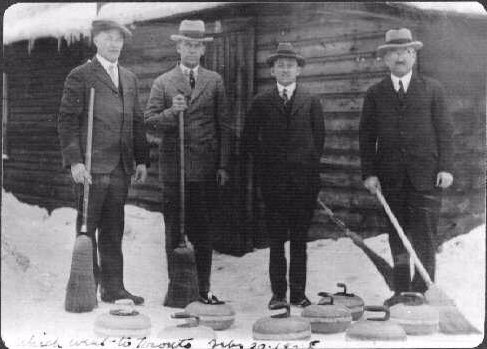|
Curling came very early in Chapleau�s story �in the winter of 1885-6, to be exact. And it certainly wasn�t an old man�s game. Chapleau�s first curlers made their own sheet of ice on a stretch of land on the east side of Lorne Street, using water from the nearby CPR engine-house and shops. Once the sheet was made, the hardy curlers had to shovel and sweep snow from it almost every time that they wanted to play.
In the years immediately following this heroic beginning, curling seems to have its ups and downs, being played only when there were enough rugged enthusiasts willing to make the outdoor ice and shovel snow.
In the late 1880s, J. Gill opened an outdoor skating rink on Lorne Street, just south of the site of the curling sheet. In the years when there were enough curlers, they could play on ice adjacent to the skating surface.
Lombard Lafrance took over the rink in 1895 and made some improvements, such as heated changing shacks, one for men, one for women, and a high board fence as a defence against drifting snow.
A giant step forward occurred in 1904 when the ice surface was entirely enclosed, completely sheltered at last from wind and blizzard. The curlers were given a single sheet of ice along the west (Lorne Street) side and later got a second sheet along the opposite wall.
In 1912 the building was taken over by �a group of citizens� who proceeded to renovate and enlarge it. Gradually the curlers� lot improved. By the early 1920s they had two adjacent sheets of ice and their very own club room at the north end of the building.
Needing more than two sheets of ice (and perhaps caught up in the infectious optimism of the Roaring Twenties), the Chapleau Curling Club left the rink on Lorne Street in 1928 for their very own four-sheet building on Pine Street.
Meanwhile, the Twenties ceased to roar when the stock markets around the world crashed in October, 1929.
Despite the Great Depression, which took some time to wreak its full devastation, the Chapleau Curling Club knew some of its happiest days after it moved into its new home on Pine Street. In 1929 and again in 1932 Chapleau was host to the Northern Ontario Curling Association Bonspiel. On these occasions the four sheets at the Curling Club were augmented by putting four more sheets on the ice in the arena on Lorne Street. Playing on home ice, Chapleau�s curlers acquitted themselves very well in 1929 and 1932.
|
Following these glory days, the Chapleau Curling Club entered a decline. Presumably, the Great Depression was making itself felt.
In 1933 or 1934, dwindling membership became an issue. The Club kicked away an obvious solution to the problem when it rejected applications for membership from the four Pirie sisters. Curling was a man�s game.
With so many men away during the Second World War, curling couldn�t make a real comeback until the late 1940s.
In the post-war years, a younger generation of curlers who had not been born in the Victorian era assumed control of the Chapleau Curling Club. Women were admitted in 1949; the Club�s finances went into the black; the debt was retired. A liquor licence helped keep the books healthy.
With their finances in robust shape, the curlers proceeded to make improvements to their building through the 50s and 60s. The club room was enlarged; a washroom was installed; and an automatic oil-burning furnace was put in. Then, in 1962, came the ultimate refinement �artificial ice! An office and a second washroom were built above the ice plant.
To help assure the future of curling in Chapleau, steps were taken to introduce young people to curling. Vincent Crichton brought School Boy Curling to town in 1954 and a year later Herb Riley donated a trophy for High School Curling to encourage competition.
The old wooden barn on Pine Street served for almost 50 years as the home for some of Chapleau�s most convivial social activity. In the mid-70s, the municipality convinced the Curling Club to join in the effort to provide the town with a modern Recreation Centre with an arena, a curling rink, and a community hall under one roof.
While the new facility is a marked improvement in every way on the drafty old place on Pine Street, it had a loveable rustic personality and was the home of innumerable good times. It is missed by those who knew it.
Written by George Evans , based on material found in Vincent Crichton�s book, Pioneering in Northern Ontario, and the author�s own recollections.
|
